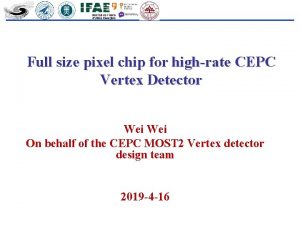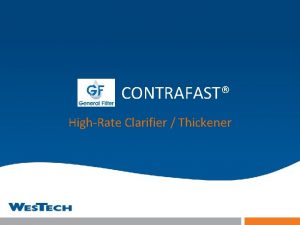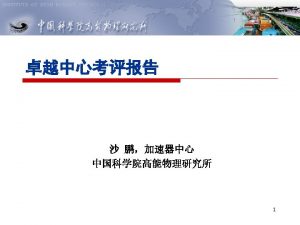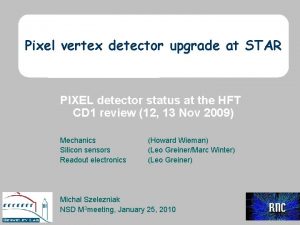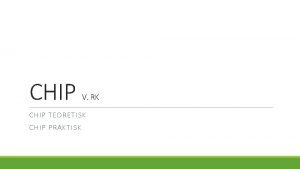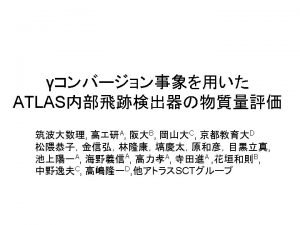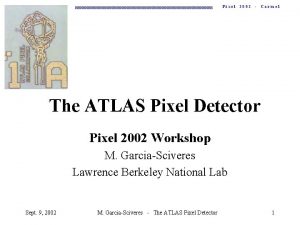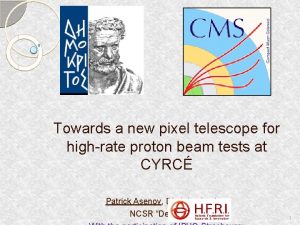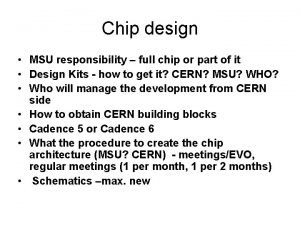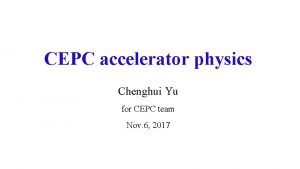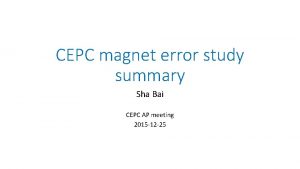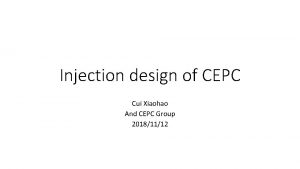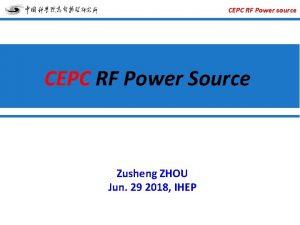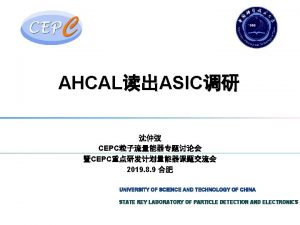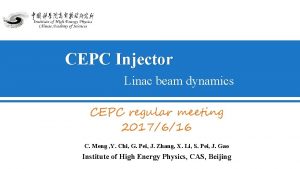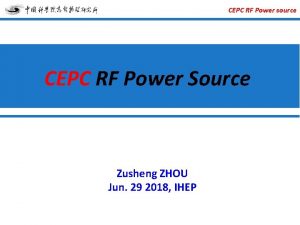Full size pixel chip for highrate CEPC Vertex






















- Slides: 22

Full size pixel chip for high-rate CEPC Vertex Detector Wei On behalf of the CEPC MOST 2 Vertex detector design team 2019 -4 -3

Outline • Motivation of the MOST 2 Vertex detector design • Specification • Limitation of the existing CMOS sensors towards the highrate CEPC Vertex Detector • Key improvement for fast readout • Preliminary design & schedule 2

CEPC Vertex Detector Design • Ref: Status of vertex detector, Q. Ouyang, International workshop on CEPC, Nov. 7 th 2017 3

Baseline Vertex Detector design • Ref: Introduction to the Pixel MOST 2 Project, Joao Costa, 2018. 6 4

Ladder Prototype • Ref: Introduction to the Pixel MOST 2 Project, Joao Costa, 2018. 6 5

• • Slides from Y. Zhang: “IHEP CMOS pixel sensor activities for CEPC”, 2018. 3 Find more details in Y. P. Lu’s presentation: “Pixel design and prototype characterization in China” this morning 6

Main specs of the full size chip for high rate vertex detector From the CDR of CEPC • Bunch spacing – Higgs: 680 ns; W: 210 ns; Z: 25 ns – Meaning 40 M/s bunches (same as the ATLAS Vertex) • Hit density – 2. 5 hits/bunch/cm 2 for Higgs/W; 0. 2 hits/bunch/cm 2 for Z • Cluster size: 3 pixels/hit – Epi- layer thickness:~18μm – Pixel size: 25μm× 25μm For Vertex Specs For High rate Vertex Specs For Ladder Prototype Specs Pixel pitch <25μm Hit rate 120 MHz/chip Pixel array 512 row× 1024 col TID >1 Mrad Date rate 3. 84 Gbps --triggerless ~110 Mbps --trigger Power Density < 200 m. W/cm 2 (air cooling) Dead time <500 ns --for 98% efficiency Chip size ~1. 4 cm× 2. 56 cm 7

Limitation of the existing CMOS sensors • None of the existing CMOS sensors can fully satisfy the requirement of high-rate CEPC Vertex Detector • Two major constraints for the CMOS sensor – Pixel size: should be < 25 um* 25 um, aiming for 16 um*16 um – Readout speed: bunch crossing @ 40 MHz • TID is also a constraint, but 1 Mrad is not so difficult ALPIDE ATLAS-MAPS MIMOSA Jade. Pix/ MIC 4 Pixel size ✔ X ✔ ✔ Readout Speed X ✔ X X TID X (? ) ✔ ✔ To be tested 8

The ALPIDE readout architecture • The ALPIDE architecture, as MOST 1 referenced, uses strobe signal as the “trigger” • However, the readout rate is only ~100 k. Hz, and more like frame readout G. Aglieri Rinella et al. NIM. A 845 (2017) 583– 587 9

Proposed architecture for MOST 2 From X. M. Wei for the CEPC Vertex MOST 2 group meeting • Similar to the ATLAS ITK readout architecture: “column-drain” readout – – – • 2 -level FIFO architecture – – • Priority based data driven readout Modification: time stamp is added at EOC whenever a new fast-or busy signal is received Dead time: 2 clk for each pixel (50 ns @40 MHz clk), negligible compared to the average hit rate L 1 FIFO: In column level, to de-randomize the injecting charge L 2 FIFO: Chip level, to match the in/out data rate between the core and interface Trigger readout – – Make the data rate in a reasonable range Data coincidence by time stamp, only the matched event will be readout 10

Pixel architecture – Analog D. Kim et al. DOI 10. 1088/17480221/11/02/C 02042 Amplification Discrimination Y. Zhang for the CEPC Vertex MOST 2 group meeting • • Digital-in-Pixel scheme: in pixel discrimination & register Pixel analog is derived from ALPIDE (and benefit from MIC 4 for MOST 1) – • As most of ATLAS-MAPS sensors’ scheme Biasing current has to be increased, for a peaking time of ~25 ns – Now in MOST 1 ~2 us peaking time was designed, too slow for 40 MHz BX • Consequence: – Power dissipation increased – Modified TJ process for ATLAS has to be used Ø With faster charge collection time, otherwise only fast electronics is of no meaning 11

Pixel architecture – parallel digital schemes • Two parallel digital readout architectures were designed: – Scheme 1:ALPIDE-like: benefit from the proved digital readout in small pixel size – Scheme 2:FE-I 3 -like: benefit from the proved fast readout @40 MHz BX (ATLAS) 12

Design effort aiming for 40 MHz BX on digital • ALPIDE-like scheme: – Fast-Or bus added to record the column hit time stamp – Boosting speed of the AERD (Address-Encoder & Reset-Decoder) Ø To shift the Fast-Or by a half of the clock cycle – More margin in the timing constraint of the periphery circuit Normal AERD Boost AERD TY. Wu for the CEPC Vertex MOST 2 group meeting • FE-I 3 -like scheme: – Simplify the pixel cell logic – All the logic gates were re-designed with fully customized layout Ø For smaller pixel size 13

Full chip periphery logic design • Main Functionality: – Trigger/Triggerless readout mode compatible Ø Data coincidence and trigger window logic – Two level FIFO for hit derandomization – High speed serialization for data readout Ø 4 Gbps data rate capability From X. M. Wei for the CEPC Vertex MOST 2 group meeting • Other necessary blocks – – – Slow control of the pixel array and full chip via SPI interface Bias generation by current- and voltage- DACs Clock management: Phase Lock Loop and serializer Power management: LDOs for on-chip low ripple power supply High speed interface: CML & LVDS Drivers 14

Current Status and recent schedule • Design Status – Schematics of the main blocks are ready – Layout in progress Ø The first version of the pixel cell layout will be ready before the Mid of April • First MPW tapeout – Shuttle booked for May 13 th via IFAE Ø One block for 5 mm× 5 mm To be submitted in May Expected to receive in Sep. Test Board design will be in parallel – Organized with a full functional pixel array (small scale), plus other test blocks (less critical) Ø A 64× 192 Pixel array + Periphery + PLL + Serializer Ø Bias generation included Ø I/O arranged in one edge, as the final chip 15

Summary • MOST 2 Vertex detector sensor design will be benefit from existing MOST 1 designs, with further development on fast readout • Readout architecture modified from “strobed-trigger” readout into “column-drain” readout – Based on priority readout and data driven – Two level FIFOs designed with negligible dead time • Time stamp added for each hit cluster – trigger coincidence will use the time stamp for arbitration • Pixel analog modified for faster peaking time – Aiming for ~25 ns peaking time – Power dissipation increased consequently – modified TJ process is necessary for faster charge collection time • Two parallel pixel digital schemes were designed, based on ALPIDE and FE-I 3, respectively 16

Thank you!

Discussion on ALPIDE – analysis & conclusion • ALPIDE is not fully compatible with CEPC vertex & other high hit rate, high bunch crossing applications (like ATLAS) 1. Bunch crossing too high – Now bunch crossing at 100~200 k. Hz (i. g. frame rate) – While CEPC 1. 5 MHz (Higgs) ~ 40 MHz(Z pole) Ø Not possible for the chip level frame-like readout, because: – At least 120 MHz clk has to run at periphery-column level (3 pixel per hit) – ALPIDE is “triggerless”, no further data reduction, data rate too high (*32 bits per hit) 2. Pixel analog should be (much) faster – now 2 us peaking, 10 us duration – CEPC: “Hit rate: 120 MHz/chip, or 225 Hz/pixel (average), 120 k. Hz/col (ave)”, Meaning every 8. 3 us, the column will be hit, however, very unlikely to be at the same pixel – For CEPC, peaking time should be much faster (25 ns level) Ø Otherwise leads to too large delay for the arrival time stamp (although can be covered by the configurable trigger match error) – For CEPC, duration should also be faster Ø Better ends earlier than 8. 3 us, avoiding continuous hit in the same pixel – Larger power expected than ALPIDE 18

From vertex detector MOST 1 projects towards MOST 2 • To build a prototype ladder mounted with silicon pixel sensors – Spatial resolution 3 -5 μm – TID 1 Mrad • Compared with MOST 1 project target: – – Pixel sensor prototype design Spatial resolution 3 -5 μm Power consumption <100 m. W/cm 2 Integration time 100 μs • MOST 1 focused on key performance, however we should focus more on a full function chip that can work in a prototype system • Baseline design for MOST 2: – Reuse the pixel design from MOST 1, with necessary modification – Focus on full chip readout architecture design, esp. fast readout and full data readout chain 19

The full size chip for high rate vertex detector • Bunch spacing From the CDR of CEPC – Higgs: 680 ns; W: 210 ns; Z: 25 ns – Meaning 40 M/s bunches (same as the ATLAS Vertex) • Hit density – 2. 5 hits/bunch/cm 2 for Higgs/W; 0. 2 hits/bunch/cm 2 for Z • Cluster size: 3 pixels/hit • • The hit rate: Higgs 11 MHz/cm 2, W 36 MHz/cm 2, Z 24 MHz/cm 2 The chip should be capable with 36 MHz/cm 2 hit rate Suppose the pixel array size is 512 rows*1024 cols (ALPIDE), 25 um*25 um pixel size, and 1. 28 cm*2. 56 cm pixel array area → Hit rate: 120 MHz/chip, or 225 Hz/pixel (average), 120 k. Hz/col (ave) – • Meaning every 8. 3 us, the column will be hit, however, very unlikely to be at the same pixel In order to readout without data loss, time stamp has to be added for every hit – – According to the readout speed of MOST 1(10~100 us), it is not capable for this large hit rate Also MOST 1 chip design (MIC 4) is currently base on ALPIDE readout architecture, which is still more or less frame-based, not fully capable with trigger readout 20

Increased data rate as for the real CEPC • • • Every hit has 27~32 bits (async): col addr 9 bits (512), row addr 10 bits (1024), time stamp ~8 bits (suppose 40 MHz clock, covers 6. 4 us time region) If triggerless, all the raw hit data should be sent off chip – The data rate: ~32 bits*120 MHz= 3. 84 Gbps, possible, but risk too high in the current stage If trigger, on-chip buffer should be designed – Suppose trigger latency 3 us. Trigger rate was said 20 k. Hz~50 k. Hz – Triggered data rate: Ø 2. 5/hits/bunch/cm 2*3 pixels/hit*1. 28 cm*2. 56 cm*32 bit=786 bit/bunch/chip Ø W@20 k. Hz trigger rate -> 15. 7 Mbps/chip as the triggered data rate – In order to cover any trigger error(mismatch of the edge in different column, time walk of the hit peaking…) Ø A trigger window can be set, so that the data within the ±σ of the trigger time stamp can all be read out Ø In this way, the readout data rate will be (suppose trigger window of ± 3 LSB time stamp): – 15. 7 Mbps * 7 ~ 110 Mbps – Can still be read out by a single LVDS interface 21

Other necessary modification for the pixel cell • Pixel analog in the same architecture as ALPIDE (and benefit from MIC 4 for MOST 1) but with different parameters – Aiming especially for fast readout • Biasing current has to be increased, in order to achieve a peaking time of ~25 ns – Otherwise there will be timing error for the event, and has to open a trigger window in this case – Now in MOST 1 ~2 us peaking time was designed, which is too slow for 40 MHz BX • Consequence: – Power dissipation increased: Ø bias@440 n. A with peaking time 29 ns, but 138 m. W/cm 2 for analog Ø Total power density may exceed 200 m. W/cm 2 – Modified TJ process for ATLAS has to be used Ø With faster charge collection time, otherwise only fast electronics is of no meaning From Y. Zhang for the group meeting 22
 Cepc logo
Cepc logo Cepc logo
Cepc logo Methylation & chip-on-chip microarray platform
Methylation & chip-on-chip microarray platform Vertex chip
Vertex chip Full pixel readout
Full pixel readout A chip of glass ruby characters
A chip of glass ruby characters![Const int size=18; string *tb12 = new string[size]; Const int size=18; string *tb12 = new string[size];](data:image/svg+xml,%3Csvg%20xmlns=%22http://www.w3.org/2000/svg%22%20viewBox=%220%200%20200%20200%22%3E%3C/svg%3E) Const int size=18; string *tb12 = new string[size];
Const int size=18; string *tb12 = new string[size]; Size separation definition
Size separation definition Redogör för vad psykologi är
Redogör för vad psykologi är Borra hål för knoppar
Borra hål för knoppar Bris för vuxna
Bris för vuxna En lathund för arbete med kontinuitetshantering
En lathund för arbete med kontinuitetshantering Bra mat för unga idrottare
Bra mat för unga idrottare Geometri för barn
Geometri för barn Svenskt ramverk för digital samverkan
Svenskt ramverk för digital samverkan Ledarskapsteorier
Ledarskapsteorier Datorkunskap för nybörjare
Datorkunskap för nybörjare Mantel för kvinnor i antikens rom
Mantel för kvinnor i antikens rom Steg för steg rita
Steg för steg rita Ministerstyre för och nackdelar
Ministerstyre för och nackdelar Tillitsbaserad ledning
Tillitsbaserad ledning Plats för toran ark
Plats för toran ark Nationell inriktning för artificiell intelligens
Nationell inriktning för artificiell intelligens
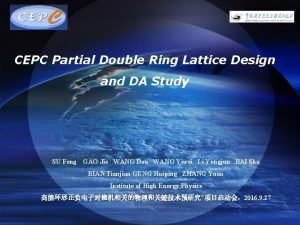

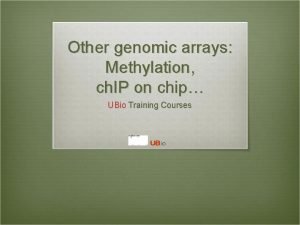
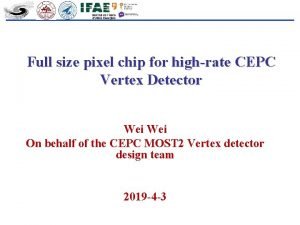
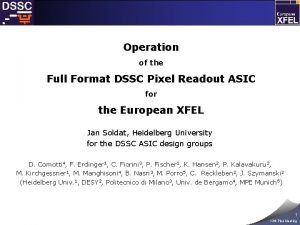

![Const int size=18; string *tb12 = new string[size]; Const int size=18; string *tb12 = new string[size];](https://slidetodoc.com/wp-content/uploads/2020/11/1588947_40cf3415d0afabae1c436a49b39f4ad0-300x225.jpg)
















